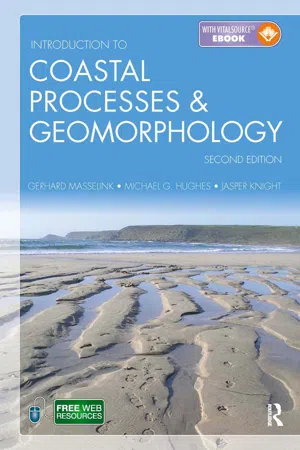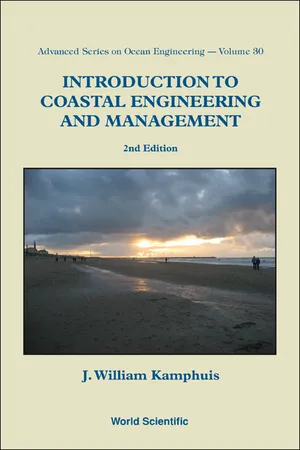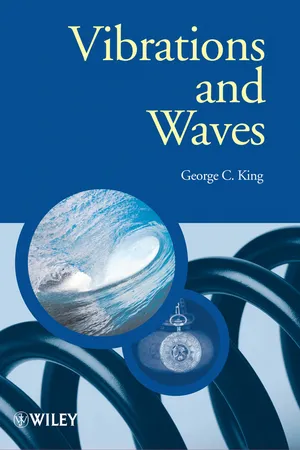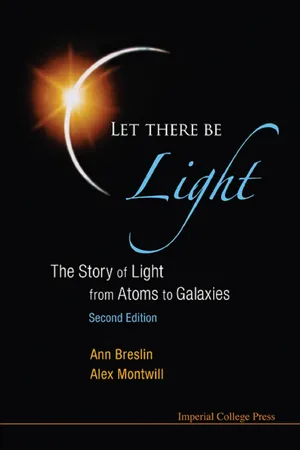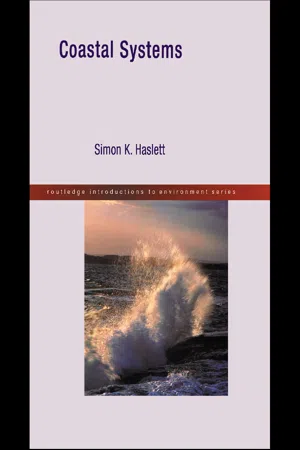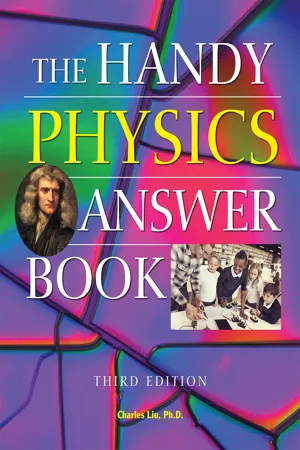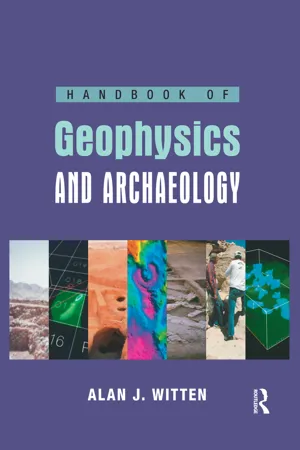Geography
Waves
Waves in geography refer to the movement of energy through a medium, typically the ocean. They are caused by the wind, tides, and other natural forces, and play a significant role in shaping coastlines and influencing coastal ecosystems. Waves can be classified based on their size, speed, and the forces that generate them, and are essential to understanding coastal geography and erosion.
Written by Perlego with AI-assistance
Related key terms
1 of 4
Related key terms
1 of 3
9 Key excerpts on "Waves"
- eBook - ePub
The Beach Book
Science of the Shore
- Carl Hobbs(Author)
- 2012(Publication Date)
- Columbia University Press(Publisher)
3Waves
Waves move energy from one place to another. Waves that break on the beach and rock boats also erode the shore and modify beaches. Wind causes most ocean Waves, so they are called wind Waves . When Waves are in deep water and cannot interact with the seafloor, gravity is the major force acting to damp them; gravity tries to restore the water to a flat surface. Because of the importance of gravity in the physics of wind Waves, they also are called gravity Waves . There are several other ways to classify Waves.When wind, even a light breeze, blows across a flat water surface, there is friction between the moving air and the still water. The resulting drag causes ripples. Rippled water has both a greater surface area than flat water and a vertical relief against which the wind can press. This results in more efficient transfer of energy from wind to water, so the ripples grow into Waves fairly rapidly. In deep water, three factors work together to determine and limit the size of the Waves: the strength (or speed) of the wind; the length of time it blows; and the unobstructed, overwater distance across which it blows. The term for the last factor is fetch . Increasing any one of the three factors allows the size of the Waves to increase unless there is some limiting influence. Some oceanographic texts and manuals have tables that relate wind speed, wind duration, and fetch to the size of the Waves. In shallow water, depth also plays a role.To talk about Waves, oceanographers have developed a standard vocabulary, and they use a standard set of symbols to represent the specific terms (figure 3.1 ). The shape of a wave, really the shape of a cross section of the wave that parallels the direction in which the wave is moving, is a trochoid (figure 3.2 - Gerd Masselink, Michael Hughes, Jasper Knight(Authors)
- 2014(Publication Date)
- Routledge(Publisher)
CHAPTER 4Waves
AIMSThis chapter presents the major processes associated with the formation, development and breaking of Waves, and are described with respect to their geometric properties. Wave development in deep and intermediate water is first examined, and then the changes in wave geometry and their eventual breaking in shallow water. Wave processes in deep, intermediate and shallow water provide the context for understanding the contribution of Waves to coastal morphological change.4.1IntroductionAlong most coastlines, Waves represent the dominant source of nearshore energy. For this reason, the global distribution of wave environments (Figure 1.5 ) is useful in classifying coastal environments because it broadly identifies the amount of wave energy available for coastal sediment transport. Part of the incoming wave energy is reflected at the shoreline and propagated back to the open sea. Most of the incoming energy, however, is transformed through its interaction with the coastline to generate nearshore currents and sediment transport, and is ultimately the driving force behind morphological change. Knowledge of wave dynamics is therefore fundamental to understanding coastal morphology.Figure 4.1 Schematic representation of the energy contained in the surface Waves of the oceans. (Modified from Kinsman, 1984.)Ocean Waves can be classified by wave period T , or by wave frequency f , which is the reciprocal of the period (f = 1/T ). Alternatively, we can classify Waves by the disturbing force that generates them, or by the restoring force that dampens the wave motion. Figure 4.1 shows a schematic wave spectrum, which plots wave energy as a function of frequency, and indicating different types of ocean Waves. Those that are addressed in this chapter are gravity Waves, which are the most energetic of the wave types and are part of the wind-forcing wave spectrum. Gravity Waves have periods of 1–30 seconds and frequencies of 0.033–1 cycles per second (or Hertz [Hz]). They are generated by wind and their main restoring force is gravity. Most of the wave terms described in this chapter are shown in Table 4.1- eBook - ePub
- J William Kamphuis(Author)
- 2010(Publication Date)
- WSPC(Publisher)
Fig. 2.3 at any particular location.On large bodies of water, the Waves will travel beyond the area in which they are generated. For example, Waves generated by a storm off the coast of Newfoundland may travel in an easterly direction and eventually arrive in Portugal. While the Waves travel such long distances, the energy of the individual Waves is dissipated by internal friction and wave energy is transferred from the higher frequencies to lower frequencies. The resulting Waves arriving in Portugal will be more orderly than the initial sea generated off Newfoundland, with longer wave periods (10-20 sec), smaller wave heights and more pronounced wave grouping (discussed in Fig. 2.10 ). Waves that have traveled some distance away from the area where they were generated are called swell. The difference between sea and swell is shown in Fig. 2.5 .Fig. 2.4 Crossing pattern of WavesOn most coasts, sea and swell occur simultaneously. The exceptions are enclosed bodies of water such as lakes, reservoirs and inland seas, where swell cannot arrive from long distances away. Even large enclosed water bodies such as the Great Lakes essentially only experience locally generated sea.Silvester (1974) discusses locations of high wind velocities and shows that there is a global wind pattern. High winds occur predominantly between 40°-60° North and South latitude. Elementary meteorology tells us that warm air flowing from the equator toward the poles and cold air flowing away from the poles meet there to form the Polar Front (Fig. 2.6 ).The earth's rotation then causes depression-type storms that move along this front. These storms occur throughout the year and at short intervals; wave conditions can be expected to vary from hour to hour throughout the year and in unpredictable patterns because this polar front shifts north-south as a result of small pressure and temperature changes1 - eBook - ePub
- George C. King(Author)
- 2013(Publication Date)
- Wiley(Publisher)
5
Travelling Waves
Waves arise in a wide range of physical phenomena. They occur as ripples on a pond and as seismic Waves following an earthquake. Music is carried by sound Waves and most of what we know about the Universe comes from electromagnetic Waves that reach the Earth. Furthermore, we communicate with each other through a variety of different Waves. At the microscopic level, the particles of matter have a wave nature as expressed by quantum wave mechanics. At the other end of the scale, scientists are trying to detect gravitational Waves that are predicted to occur when massive astronomical objects like black holes move rapidly. Even a Mexican wave travelling around a sports arena has many of the characteristics of wave motion. It is not surprising therefore that Waves are at the heart of many branches of the physical sciences including optics, electromagnetism, quantum mechanics and acoustics.In this chapter we begin to explore the physical characteristics of Waves and their mathematical description. We distinguish between travelling Waves and standing Waves . Ripples on a pond are an example of travelling Waves. A plucked guitar string provides an example of a standing wave. The present chapter is devoted to travelling Waves while standing Waves will be discussed in Chapter 6. Travelling Waves may be either transverse Waves or longitudinal Waves . We have already seen the difference between these two types of motion in Chapter 4. In transverse Waves the change in the corresponding physical quantity, e.g. displacement, occurs in the direction at right angles to the direction of travel of the wave, as for the outgoing ripples on a pond. For longitudinal Waves, the change occurs along the direction of travel. An example of this is the longitudinal compressions and rarefactions of the air that occur in the propagation of a sound wave. It is easier to see the physical processes going on in a transverse wave and so we will concentrate on them in the present chapter. However, both transverse and longitudinal Waves are solutions of the wave equation , which is one of the most fundamental equations in physics. We will deal with mechanical Waves that travel through some material or medium - eBook - ePub
Let There Be Light
The Story of Light from Atoms to Galaxies
- Ann Breslin, Alex Montwill(Authors)
- 2013(Publication Date)
- ICP(Publisher)
Chapter 6Introducing WavesWhat is a wave? Waves are so diverse that we might tend to regard different types of Waves as separate entities, unrelated to one another. Do events such as the devastation of a region by an earthquake and the melodic tones of a musical instrument have anything in common? In this chapter we explore the common ground between these and many other phenomena.Waves carry energy from one place to another. They also act as messengers, transmitting information. We look at different types of Waves, how they are created, what they are ‘made of’ and how they carry out their functions of carrier and messenger.To deal with some aspects of wave behaviour, we need to express the properties of the Waves mathematically. We can then make quantitative predictions regarding many wave-related phenomena seen in nature. In a mathematical analysis of Waves, it is most convenient to use the simplest type of wave form — a continuous sine wave. It is gratifying, if rather startling, to find that even the most complicated periodic Waves can be constructed simply by adding a number of these sine Waves.6.1 Waves — the basic means of communicationWhen talking about Waves, we most likely picture a seaside scene with ocean Waves approaching the shore or perhaps a ship at sea tossed in a storm. A survey asking the question ‘What serves as the most common means of communication?’ would be unlikely to favour the answer ‘Waves’. Yet, heat and light from the sun are carried by Waves. We could neither see nor speak to one another were it not for light Waves and sound Waves. Even the sensation of touch relies on the transmission of nerve impulses, which are composed of wave packets.Waves on a sandy beach at Cabo Polonio, Uruguay. Courtesy of Johntex, 2006.Electromagnetic Waves, which pervade all space, and without which the universe could not exist, are the basic theme of this book. Light - eBook - ePub
- Simon Haslett(Author)
- 2000(Publication Date)
- Routledge(Publisher)
Figure 2.1 ). For example, the mid-latitudes in both northern and southern hemispheres experience regular storms which in turn can produce very large Waves. Storm wave affected coasts, therefore, occur in the path of major storm tracks, such as northwest North America from Oregon to Alaska, northeast North America from Florida to Newfoundland, northwest European coasts of France, British Isles and Scandinavia, Atlantic and Pacific coasts of southern South America and southerly coasts of Australia and New Zealand. Storm wave affected coasts also occur in tropical latitudes, such as southeast Asia and the Arabian Sea, where they regularly experience tropical cyclones. Outside these storm belts, Waves on open ocean coasts tend to be smaller, but may still be significant in influencing coastal development. This is at a minimum, however, in the subtropical doldrums, where wind activity is least intense. Enclosed sea coasts, such as the Mediterranean and Red Seas, experience minimum wave conditions due to their size, which prohibits the development of large Waves (see next section). However, it is coasts in polar regions that are least affected by Waves because for long periods of the year (if not permanently) their coasts are protected by the formation of coastal sea ice.Figure 2.1 The distribution of global wave environments: coasts experiencing >5m high Waves are storm-affected.Source: from Briggs et al. (1997) (Figure 17.18, p. 319)Waves
All Waves possess alternating high crests and low troughs, and can be described (Figure 2.2 ) with reference to:- wave-height (H), the vertical distance between the wave trough and crest;
- wave-length (λ), the horizontal distance between consecutive crests or troughs; and,
- wave-period (T), the time interval between consecutive wave crests or troughs passing a fixed point.
Waves represent the transfer of energy, behaving differently depending on whether they are in deep or shallow water (Figure 2.3 ). In deep water, there is only minor movement of water in the wave. Although energy passes forward within a wave, water follows a circular pattern. A water particle may, from a starting position at the bottom of a wave trough, move up the face of an oncoming wave, against the direction in which the wave is travelling, to reach the crest and return to its original position. It will then travel down the back of the wave under gravity, this time moving forward with the wave, but finishing back at the bottom of the next wave trough at its original starting position. This closed loop, where a water particle moves in a circular orbit, has given rise to the name oscillatory wave. The diameter of water particle orbits decreases with depth through the water column, so that eventually a depth is reached below which the water is unaffected by Waves passing overhead. This depth is called the wave-base, - eBook - ePub
- Charles Liu(Author)
- 2020(Publication Date)
- Visible Ink Press(Publisher)
Waves
What is a wave?
A wave is a traveling disturbance that moves energy from one location to another without transferring matter. Oscillations in a medium or material create mechanical Waves that propagate away from the location of the oscillation. For example, a pebble dropped into a pool of water creates vertical oscillations in the water, while the wave propagates outward horizontally along the surface of the water.What are the two main forms of Waves?
Transverse Waves and longitudinal Waves are the two major forms of Waves.In a transverse wave, the wave itself and its energy move away from the source perpendicular to the direction of the oscillations. A transverse wave can be created, for example, by repeatedly shaking a string or rope up and down. The string moves up (the highest point is called the “crest”) and down (the lowest point is called the “trough”) while the wave travels.The oscillations in longitudinal Waves move in the same direction that the wave is moving. A longitudinal wave can be created, for example, by repeatedly pushing and pulling on a long, soft spring.Can the two main forms of Waves be combined?
Yes, they often do combine. Ripples in a pond, for example, are a combination of transverse and longitudinal Waves that can move outward in circles. As in the case of transverse and longitudinal Waves alone, energy is transferred, but matter is not moved.What determines the velocity of a wave?
The velocity of a wave depends upon the material or medium in which it is traveling. Typically, the stronger the coupling between the atoms or molecules that make up the medium and the less massive they are, the faster the wave will travel. All Waves of the same type (transverse or longitudinal) travel at the same speed through the same medium. For example, a sound wave in air at 0°C will travel at 331 meters per second regardless of the sound’s frequency or amplitude. - eBook - ePub
The Atmosphere and Ocean
A Physical Introduction
- Neil C. Wells(Author)
- 2011(Publication Date)
- Wiley(Publisher)
gh ).Long Waves in the ocean may be caused by large falls in surface pressure associated with tropical cyclones or by seismic activity. These Waves, like swell Waves, tend to follow great circle routes, and the location and time of generation of the Waves can be obtained by noting the time of their arrival and period at the coast. By this method the origins of major submarine earthquakes have been located in the Pacific Ocean. In deep water such as the Pacific Ocean, the variations in bottom depth are relatively small compared with the total depth of the ocean and therefore the wave speed is little affected by the bottom. However, in shallow water the bottom variations reduce the speed of the long Waves considerably. As a wave approaches a shore its speed will diminish but its frequency will remain unchanged, and so the wavelength becomes shorter and the Waves appear to bunch together. Mathematically:8.8The flux of energy per unit time, F, across a coast is the product of the wave-energy density and the group velocity. This flux of energy, F, will remain constant and therefore, because of the reduction in group velocity, the wave-energy density must increase. The wave energy is proportional to the square of the wave height and hence the wave height, H, will increase as the shore is approached. Thus:and8.9If a wave has height H 1 in water of depth h 1 , then equation 8.9 implies that its height H 2 in water depth h 2 is given by:8.10For a tsunami which has an elevation of 1 m in water 4 km deep propagating into a coastal region having water 10 m deep:Tsunami Waves between 3 and 5 m high have been measured in coastal locations in the Pacific Ocean. It is also noted that, for a tsunami wavelength of 100 km in water 4 km deep, equation 8.8 - eBook - ePub
- AlanJoel Witten(Author)
- 2017(Publication Date)
- Routledge(Publisher)
Thus far, static methods have been used to characterize the shallow subsurface environment. The term 'static' implies that the quantity of interest does not change over time. Waves are 'dynamic' meaning that they are quantities that vary over time. In the static methods considered (gravity and magnetometry), characteristics of buried objects are inferred from spatial changes in the gravitational acceleration and magnetic field. In particular, feature depth can only be estimated indirectly from these spatial variations (Sects. 4.12 and 2.12.1). Dynamic methods are complicated by the need to record and interpret temporal variations as well as spatial variations. With this complication comes additional benefits in feature characterization, and perhaps the most important of these benefits is the direct determination of object depth. This chapter will introduce some basic concepts of Waves that are necessary to the understanding of the use of Waves in geophysics, In many respects, Waves are a more difficult topic than the previously presented static methods; however, Waves are more intuitive since Waves are exploited in daily life. The human body cannot directly 'sense' magnetic fields and, while the body can 'sense' gravity, it is not sufficiently sensitive to provide any experience as to the 'feel' of changing gravitational acceleration. Conversely, there is a great deal of direct experience in sensing and exploiting Waves. Both light and sound are wave-based phenomena and these types of Waves are sensed by sight and hearing, respectively, and interpreted by the brain. Thus, there are instinctive skills used in exploiting Waves that can be directly called upon for use in the geophysical exploitation of Waves.6.1 Characteristics of Waves
In geophysics, the most important characteristic of Waves is that they propagate. Propagation means traveling with a certain speed and, because Waves propagate, it is possible to directly measure distances. For example, consider driving a car at a constant speed between two cities without stopping. By knowing the speed and measuring the time required to complete the drive, it is possible to determine the distance between the two cities. This introduces the most fundamental relationship used in the analysis of Waves. This is, that distance is equal to speed multiplied by travel time. Denoting speed by c, time by t , and distance by l , and assuming for illustration purposes that the driving speed is 30 kilometers per hour and that the trip requires three hours, the distance between the two cities is simplyl = c X t = 90 km.Although traveling in a car does not involve Waves, this simple example is quite similar to a wave-based measurement. To illustrate this, consider throwing a pebble into a pool of water (Fig. 6.1 ).Figure 6.1. Illustration showing water Waves propagating away from the point of impact of a pebble.As is well known and illustrated here, the impact of the pebble on the water surface produces Waves that appear as circular ripples. To determine the distance from the point where the pebble hits the water it is sufficient, knowing the speed of the wave, to measure the time required for the wave to reach a particular point and then compute the distance using l = c X t.Perhaps a better example is a digital tape measure. This device emits a short burst of high frequency (above audible) sound. This sound travels with a characteristic wave speed (about 340 meters per second in air), bounces off an object and returns to the instrument where the returning wave is detected. The use of a digital tape measure to determine the distance to a wall is shown in Fig. 6.2.
Index pages curate the most relevant extracts from our library of academic textbooks. They’ve been created using an in-house natural language model (NLM), each adding context and meaning to key research topics.
Explore more topic indexes
Explore more topic indexes
1 of 6
Explore more topic indexes
1 of 4

